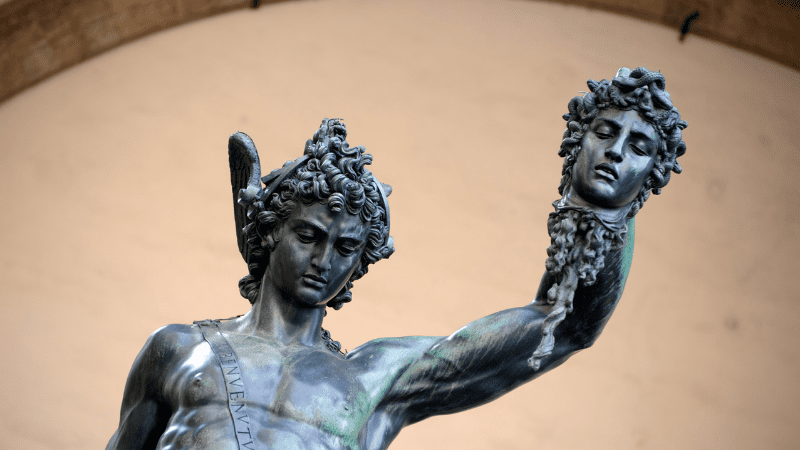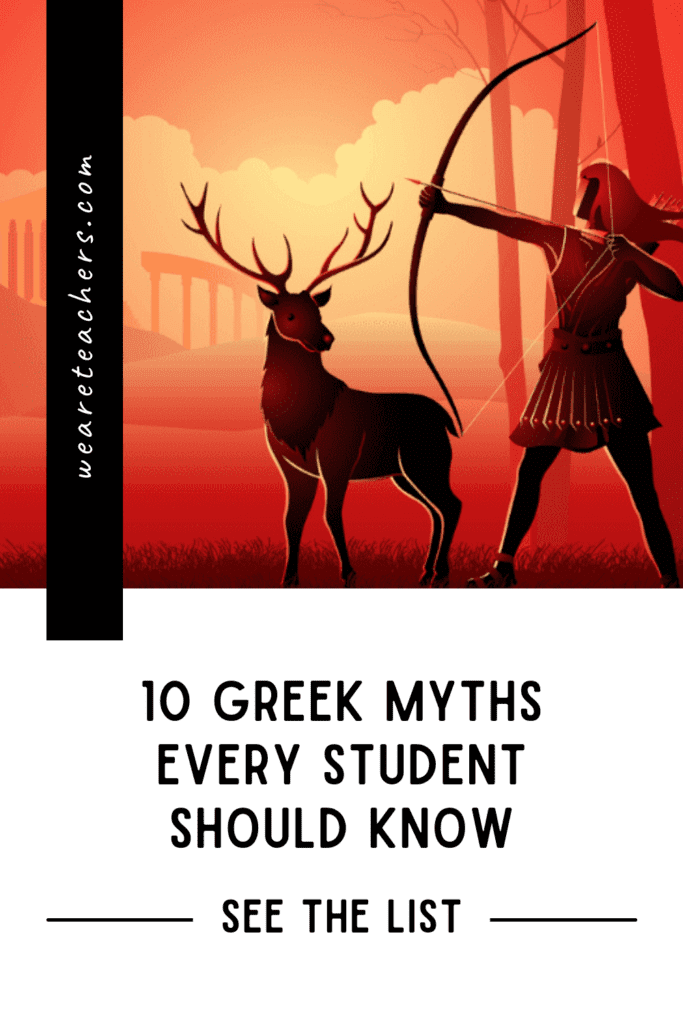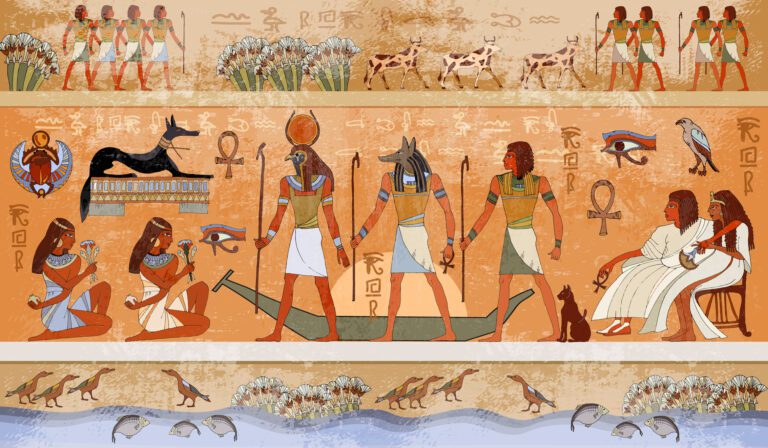From building background knowledge of where modern terms and phrases originated to important life lessons humans have been grappling with for centuries, there is a Greek myth for all of it. Here are 10 great Greek myths that your students should know and a few ways to integrate them into your lessons.
1. Gordias and the Gordian Knot

Summary:
King Gordias wins his throne in a most unusual manner. Born a peasant, he receives a sign from Zeus telling him to ride into town on his oxcart. He does, only to discover that the king has just died and an oracle has told the people that their new king will be arriving soon … by oxcart! After being crowned, Gordias ties up his cart in the town square in honor of Zeus. The knot is so complex that it inspired a legend. The man who unties/undoes the Gordian knot is destined to rule over all of Asia.
Classroom applications for this great Greek myth:
- History/Social Studies: This Greek myth is perfect for a middle- or high school-level discussion about the places in history where legend and truth get a bit cloudy. The puzzle of the Gordian knot was eventually solved, so the story goes, by a real-life person, Alexander the Great. And he did, in fact, go on to conquer and rule much of Asia. What a great launch activity or conversation topic for a class studying the history of ancient Greece or Western civilization. If Alexander the Great really exists, does that mean the Gordian knot does too? What about King Gordias and his prophetess queen?
- English/Language Arts: This story has many potential ELA links. The metaphor of the “Gordian knot,” an unsolvable puzzle or one that can only be solved by thinking “outside the box,” is common in literature. Sharing it builds students’ background knowledge and shows how complex and intertwined legend and history can become. Especially when you consider that King Gordias, who quite possibly did exist historically, had a fairly famous son in the world of Greek myth.
2. King Midas

Summary:
King Midas is King Gordias’s only son. One day, he meets the god Dionysus, who takes a liking to Midas and decides to grant him one wish. Without thinking, Midas wishes that everything he touches be turned to gold. After turning most of his palace, his food and wine, and (in some versions of the myth) his beloved daughter to gold, Midas realizes his gift is actually a curse. Depending on the retelling, Dionysus either takes pity on King Midas and removes the golden touch or poor Midas starves to death.
Classroom applications for this great Greek myth:
- Elementary classes: This myth is perfect for younger students because it avoids a lot of the more adult themes that are often present in Greek myths. Students of all ages will recognize the thematic concepts of greed, lack of forethought, and penance found in King Midas’s story.
- English/Language Arts: For older students, it may be interesting to have them reflect on modern examples of King Midas’s weakness. They will have little trouble identifying people who sought great wealth only to suffer a fall from grace in today’s world.
- Science/Mathematics: While requiring a bit more planning, the King Midas story could be an excellent launch for a discussion about elements and their identifying properties. What would a grape made of solid gold weigh? If Midas’s clothes turned to gold, would he be able to walk? Experiments or math problems based on these ideas would gain student interest and get them talking about the real-world possibilities of this myth.
3. Arachne the Weaver

Summary:
Arachne is the best weaver on earth and she knows it. After refusing to thank the goddess Athena for the gift (Athena is the goddess of weaving as well as wisdom and war), Athena challenges Arachne to a weaving contest. Arachne agrees. When the contest is over, even Athena has to admit that Arachne’s work is better. In a rage, Athena turns Arachne into the world’s first spider, forcing her and her descendants to weave beautiful webs for the rest of time.
Classroom applications for this great Greek myth:
- Science: What a great introduction to a biology unit on arachnids, right? It’s also great for any unit that has to do with understanding how things came to be. The Greeks had a bunch of myths that they used to explain and understand nature that would be ideal to pull into a science lesson.
- English/Language Arts: In addition to working well in lessons on word origins, the myth of Arachne would work beautifully as a mini-lesson on identifying theme. The Greeks were really big on showing the proper respect and humility in front of their gods. They believed that mortals who were arrogant would be punished for their pride. Simple stories like this often make challenging concepts like identifying thematic ideas or making thematic statements easier.
- Elementary: Perfect for a creative writing unit. Read this myth to your class and ask the students to create their own stories explaining how an animal came to be or how some other aspect of the natural world exists.
4. Echo and Narcissus

Summary:
Echo is a forest nymph cursed by Hera, the queen of the gods, to only be able to repeat the last few words said to her by others. She encounters Narcissus, a shockingly handsome mortal who has gotten lost in the woods and falls madly in love. Narcissus, however, has no interest in Echo and quickly grows annoyed with her repeating his own words back to him. He tells her to go away. Echo, in despair, slowly fades away until nothing but her voice remains. Meanwhile, Narcissus becomes bewitched with his own reflection after bending to take a drink from a pond. Vowing to stay there until the beautiful image loves him back, Narcissus sits beside the pond for weeks. Eventually, he too wastes away, becoming the lovely flower that bears his name to this day.
Classroom applications for this great Greek myth:
- Psychology: Echolalia and Narcissistic Personality Disorder are both medically and legally recognized as mental illnesses today. This story could introduce students to the origins of these conditions and many others. The word “narcissist” is often used by our older students. But how many of them actually know where the word comes from or how it got its meaning? This could be an interesting way to introduce the medical history behind some psychological concepts.
- Science: This is a great story to read as a way to start a discussion about how our understanding of science and nature change over time. For the ancient Greeks, these stories were their religion, their entertainment, their history, and, yes, their science. The stories dictated how they understood the world around them.
- English/Language Arts: Greek myths make excellent stories for mini-lessons on literary elements. Just think about how easy it would be to review characterization with the story of Echo and Narcissus. Indirect characterization? How about Hera’s punishment of Echo instead of going after her unfaithful husband? Or Narcissus falling in love with himself? Thematic concepts? Jealousy, love, punishment, revenge, pride, arrogance. The ancient Greeks sure knew how to pack a lot into a short story!
5. Sisyphus
Summary:
Sisyphus is a Greek prince who outsmarts Hades not once but twice. After cheating death and living a long and happy life, Sisyphus finally dies of old age. When he arrives in the Underworld, Hades is eagerly awaiting him. Instead of letting him float around as a shade for the rest of time, Hades condemns Sisyphus to Tartarus, the darkest realm of the Underworld. Here, Sisyphus and other evil mortals are brutally punished for eternity. Sisyphus’s punishment is to struggle and strain to push a heavy boulder to the top of a steep hill. Just as the boulder is about to reach the top, it slips and rolls back down to the bottom of the hill. Sisyphus has to trudge back down and start all over again. And again. And again. Forever.
Classroom applications for this great Greek myth:
- English/Language Arts: There are so many English words that have origins tied to Greek mythology that entire mini-units can be devoted to their study. “Sisyphean,” a word that usually denotes a task or job that is pointless, endless, or that can never really be completed, owes its origins to Sisyphus’s eternal punishment.
- Reading: In many ways, Sisyphus is one of the first antiheroes. He is not a good man, but in many retellings, we definitely find ourselves laughing at his antics and rooting for him as he outsmarts the gods.
- Mathematics: The first time Sisyphus cheats death, he actually stops people from dying altogether by trapping Thanatos, the ancient Greeks’ version of the Grim Reaper on Earth. The gods only notice when Ares, the god of war, complains about how boring battles are when nobody dies. This story could make a fascinating opening for a lesson on exponential growth and what might happen to the world’s population if no one ever died.
6. Pyramus and Thisbe

Summary:
See if this one sounds a bit familiar. Pyramus and Thisbe are two teenagers madly in love with each other. Their parents, however, are bitter enemies and forbid the two from ever being together. In secret, the teens plan to meet up at a nearby mulberry tree and elope. When the night arrives, Thisbe makes it to the spot first but is forced to run away. A bloody-jawed lioness, fresh from a kill, is lying directly under the tree. As she flees, her cloak is left behind. Later, when Pyramus shows up, he sees the lioness tearing the cloak to pieces. Fearing the worst, Pyramus removes his dagger and plunges it into his heart, dying instantly. Thisbe returns later, and upon seeing Pyramus’s body, takes his dagger and kills herself as well. From that day on, the formerly white berries of the mulberry bush became red, stained with the blood of the young lovers.
Classroom applications for this great Greek myth:
- English/Language Arts: Students love to discover that “Romeo and Juliet” was heavily influenced by an earlier story. This myth is a great way to get students fired up for discussions about background knowledge, plagiarism, citing text, and paraphrasing.
- Argument/Discussion: This myth has many issues that could inspire interesting conversations/arguments in different subject areas. Discussions of the destructive power of feuds, teenagers being impulsive or irresponsible, drawing incorrect conclusions, and behaving rashly are all potential topics of debate or discussion.
7. Pandora’s Box

Summary:
To punish mankind for using fire given to them by the god Prometheus, Zeus creates woman. He makes her beautiful but devious and gives her a box filled with death, disease, and all the other miseries and sufferings of the world. He sends her to to earth with specific instructions not to open the box for any reason. Soon after arriving on earth, the curious Pandora opens the lid of the box, releasing all the evils of life into the world. She slams the lid back on the box as quickly as she can, and even though she had released pain and suffering, hope remains inside the box. According to the Greek myth, this is because Zeus wants humans to suffer but also have hope that if they pray to the gods, the gods might help them.
Classroom applications for this great Greek myth:
- Mathematics: Okay, I know I’m stretching a bit, but as an “English person,” I would have loved to have had a math teacher who used stories like this when introducing concepts like volume or other geometric terms. How big would a box have to be in order to store all the evils of the world, for example?
- English/Language Arts: The name Pandora means “the one with all the gifts,” which is a great opening for a discussion on irony and/or foreshadowing. Additionally, this is one of those words that has a modern connection, the Pandora music app. Get students thinking about why an app might choose that particular name. (It’s also the name of the planet from the movie Avatar.)
- Social Studies/Health: This Greek myth provides an interesting segue into a conversation on gender roles and stereotypes. Man was created by Prometheus and given the gift of critical thinking, but Pandora was made by Zeus for the specific purpose of causing chaos and suffering. What does this say about the way the ancient Greeks viewed men and women?
8. Icarus

Summary:
Icarus, the son of Daedalus, the ingenious craftsman who created the Minotaur’s labyrinth, lives in Crete with his father. They are prisoners of King Minos. In order to escape, Daedalus invents beautiful wings made from feathers and wax. The pair put on the wings and fly away from Crete. The escape plan is a success. Daedalus warns Icarus that the wings are fragile and that he shouldn’t fly too close to the ocean or the dampness will make the wings too heavy. Daedalus also warns Icarus not to fly too close to the sun or the wax will melt, but Icarus can’t help himself. He loves the feeling of soaring through the clouds in the bright sunshine. He flies higher and higher until he can no longer hear his father’s pleas for him to be careful. The wax melts and Icarus plummets into the sea and drowns.
Classroom applications for this great Greek myth:
- Elementary: Perfect as a starting point for conversations about rules and why they matter, the story of Icarus is a cautionary tale. Students could discuss why Icarus didn’t listen to his father, why rules matter even if we don’t want to obey them, and what Icarus could have done differently to still have fun while staying safe.
- English/Language Arts: This myth is another that lends itself to discussions about thematic concepts like hubris. Students could be asked to consider the common idiom “flying too close to the sun,” and find modern examples of people who “made the same mistake” as Icarus.
- Science: Daedalus’s inventions are fantastic (and some are downright scandalous!). A discussion of some of his more school-appropriate inventions would be a wonderful launch for a makerspace of invention activity. Students could be challenged after a lesson on flight and/or aeronautics to discuss why the wings wouldn’t work or to invent their own method of (hypothetical) personal flight.
9. Medusa

(WeAreTeachers Note: The myth of Perseus is one of the most commonly shared of the Greek myths. Often, however, it is told from the hero’s perspective. The tale of Medusa is equally fascinating, but it is much sadder and more troubling. It contains depictions of sexual assault and abuse. While it is a myth worthy of study and discussion by older students, it should be approached with care.)
Summary:
Medusa is a Gorgon, a hideous monster with serpents instead of hair. If she looks at you, you will instantly be turned to stone. But she wasn’t always a monster. Medusa was once a beautiful maiden, a priestess to the virgin goddess Athena. One day, the god Poseidon sees Medusa and decides he wants her. He attacks her in Athena’s temple. When Athena realizes that Medusa has been defiled in her temple, she punishes not Poseidon, her uncle and fellow god, but Medusa, turning her into a terrible monster that no man would ever wish to look upon ever again. Medusa lives her life like this until one day, the hero Perseus, slays her, bringing her head home to use as a weapon against his enemies. Afterward, he lays her head at the foot of the statue of Athena. Athena places it on her shield as a symbol of her power.
Classroom applications for this great Greek myth:
- English/Language Arts: We chose to tell this myth from the Medusa perspective rather than the Perseus perspective it’s usually told from because it makes it a fascinating study on point of view. If this myth is told as Perseus’s story, it’s a heroic tale of a demi-god slaying a horrible monster. From Medusa’s point of view, however, this is a tragic tale of the gods taking advantage of a mortal woman again and again. Students are usually quite angry to learn this side of the story. It would make an excellent creative-writing prompt.
- Science: Although much more suited to older students, there is a lot of research about how the description of Medusa as a monster is very similar to depictions of what happens to human bodies after death. In fact, many religions have gods or monsters who are depicted similarly, indicating a long-standing human fear about what happens to us after we die. This would make an interesting lesson in how mankind makes sense of frightening things it doesn’t understand.
- Social Studies/History: Looking at any of the Greek heroes and comparing them to our heroes today is an excellent activity. The ancient Greeks valued strength, courage, and the quest for fame. Would your students say that we value the same things today? Or would they say our society values different things?
10. Atalanta and the Golden Apples

Summary:
Atalanta is abandoned in the forest as a baby by her father, who wished she was a boy. She’s raised by first a bear and then some hunters, who teach her how to be an amazing athlete and hunter even though she’s a girl. Eventually, her father decides she’s become so famous for her hunting skills he should bring her home, but only if she agrees to get married. Atalanta agrees, but only if the man can beat her in a foot race. Many men try, but none succeed. Eventually, one suitor prays to Aphrodite, the goddess of love, for help. Aphrodite gives him golden apples to throw in Atalanta’s path during the race. The young man does this and they succeed in slowing down Atalanta, who stops to pick them up. The young man, Hippomenes, wins the race and marries Atalanta.
Classroom applications for this great Greek myth:
- English/Language Arts: Often, Greek myths are wonderful to use as prompts for creative writing activities. Imagine asking students to write about the race from different perspectives. Did Atalanta choose to lose the race? If so, why? Why was Atalanta so easily distracted by the apples? Did Hippomenes play fair given how many other men had tried to win the race before him but failed?
- Social Studies/History: Another excellent myth to read as a launch or additional text when discussing gender roles in different cultures. Atalanta is shown to be a skilled hunter and athlete, so many students are somewhat perplexed as to why she is so easily tricked by the apples. In some versions of the myth, they are magical, drawing Atalanta’s attention despite her better judgement. In other versions, Atalanta likes Hippomenes and doesn’t mind the ruse as it gives her an excuse to lose the race.
- Mathematics: The combining of Greek myths and mathematics might not be immediately obvious, but that can be part of the fun. Give your students a Greek myth like this one at the end of a unit and ask them to come up with math problems based on what they’ve learned in class and the events of the story.
What other great Greek myths could be used as lessons for students? Let us know in the comments.
Plus, for more articles like this, be sure to subscribe to our newsletters.



